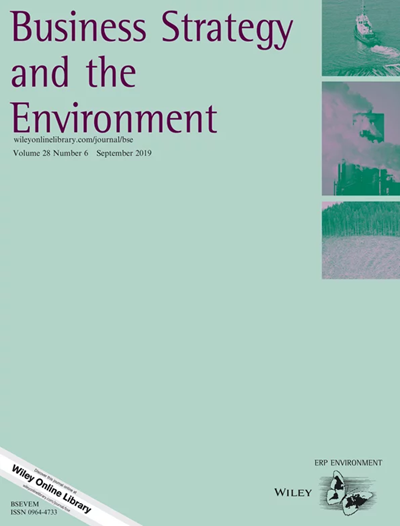IF 12.5
1区 管理学
Q1 BUSINESS
引用次数: 0
摘要
最后一英里通常面临着独特的挑战,如拥挤的城区、不可预测的客户可用性以及个性化服务的需求。为了解决这些复杂问题,并提高市场竞争力,越来越多的公司开始采用创新解决方案。众包(CS)就是这样一种创新解决方案。沃尔玛于 2013 年首次提出了众包的概念,即商店的顾客可以充当众包商,通过在回家路上运送包裹来满足在线零售商或商店的需求,并保证获得报酬。为了解影响 CS 的因素及其激励物流公司交付的潜力,本研究工作确定了影响电子商务物流领域采用 CS 的 20 个关键可持续和弹性因素。此外,还采用了中性最佳-最差法(NBWM)对这些因素进行优先排序,然后应用中性解释结构模型(NISM)和交叉影响矩阵乘法分类(MICMAC)分析来评估这些因素之间的相互关系。NBWM 的结果显示,成功实施 CS 的技术、评级和奖励制度、交付成本-时间效率、二氧化碳排放和服务质量是权重最高的五个因素。NISM 的结果表明,成功实施企业社会责任的技术、企业社会责任与主流(运营研究模型)的整合、政府干预和备用司机的使用是驱动力最高的因素。建议的 NBWM 和 NISM 为从业人员和政策管理者提供了方向,帮助他们规划可持续和有弹性的战略,以解决电子商务物流领域的 CS 实施因素。此外,管理者还可以根据优先级以及 CS 实施因素的驱动力和依赖力来制定适当的战略。本文章由计算机程序翻译,如有差异,请以英文原文为准。
Navigating the Future: Examining Sustainable and Resilient Drivers Shaping the Integration of Crowdshipping in E‐Commerce Logistics
The last mile is often subjected to unique challenges such as congested urban areas, unpredictable customer availability and the need for personalized services. To address these complexities, and to be competitive in the market, companies are increasingly turning towards innovative solutions. One such innovative solution is crowdshipping (CS). The concept of CS was first introduced by Walmart in 2013, where store customers may act as crowdshippers and fulfill the demands of online retailers or shops by transporting packages on their way home with guaranteed compensation. To understand the factors influencing CS and its potential to motivate logistics firms for delivery, this research work determines the 20 key sustainable and resilient factors affecting the adoption of CS in the e‐commerce logistics sector. Furthermore, the Neutrosophic Best‐Worst Method (NBWM) is employed to prioritize these factors, followed by the application of Neutrosophic Interpretive Structural Modeling (NISM) with cross‐impact matrix multiplication applied to classification (MICMAC) analysis to assess the interrelationships amongst the factors. The results of the NBWM reveal that technology for the successful implementation of CS, rating and reward system, delivery cost–time efficiency, CO2 emissions and service quality are the top five highly weighted factors. The results of NISM dictate the technology for the successful implementation of CS, integration of CS with the mainstream (operations research models), government interventions and the usage of back‐up drivers as the factors with the highest driving power. The proposed NBWM and NISM give direction to practitioners and policy managers in planning sustainable and resilient strategies for addressing CS implementation factors in the e‐commerce logistics sector. Further, competent strategies can be developed by the managers based on the prioritization and the driving and dependence power of CS adoption factors.
求助全文
通过发布文献求助,成功后即可免费获取论文全文。
去求助
来源期刊

Business Strategy and The Environment
Multiple-
CiteScore
22.50
自引率
19.40%
发文量
336
期刊介绍:
Business Strategy and the Environment (BSE) is a leading academic journal focused on business strategies for improving the natural environment. It publishes peer-reviewed research on various topics such as systems and standards, environmental performance, disclosure, eco-innovation, corporate environmental management tools, organizations and management, supply chains, circular economy, governance, green finance, industry sectors, and responses to climate change and other contemporary environmental issues. The journal aims to provide original contributions that enhance the understanding of sustainability in business. Its target audience includes academics, practitioners, business managers, and consultants. However, BSE does not accept papers on corporate social responsibility (CSR), as this topic is covered by its sibling journal Corporate Social Responsibility and Environmental Management. The journal is indexed in several databases and collections such as ABI/INFORM Collection, Agricultural & Environmental Science Database, BIOBASE, Emerald Management Reviews, GeoArchive, Environment Index, GEOBASE, INSPEC, Technology Collection, and Web of Science.
 求助内容:
求助内容: 应助结果提醒方式:
应助结果提醒方式:


